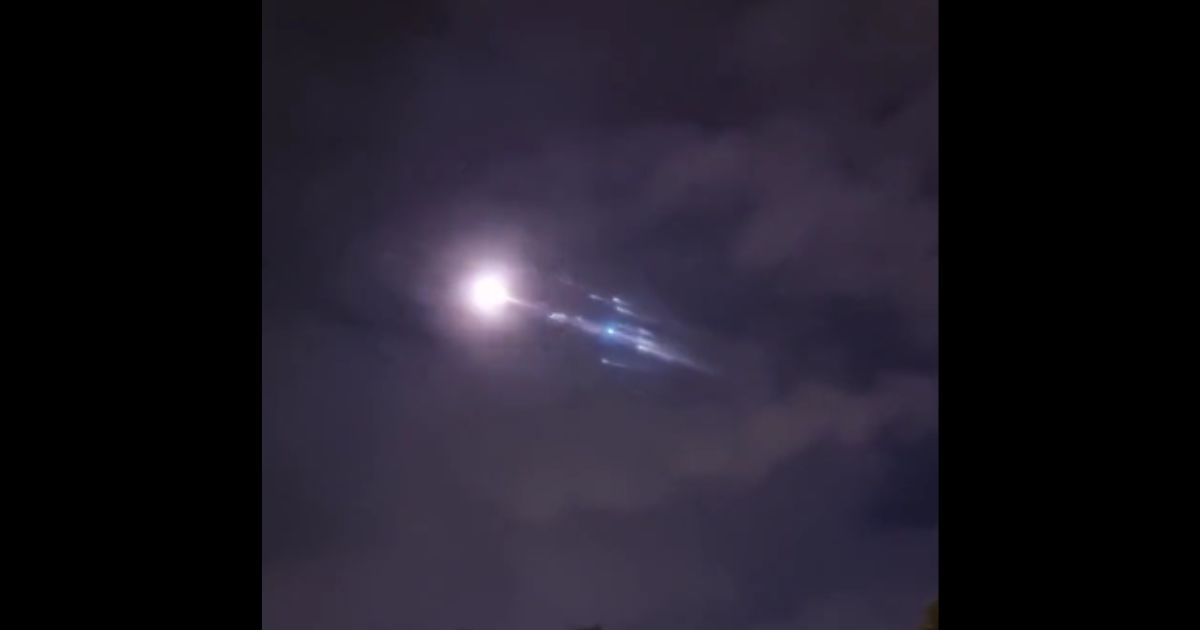Debris from a 25-ton Chinese Long March 5B rocket crashed to earth on Saturday afternoon over the Indian Ocean. This is not the first time the Chinese have failed to control the reentry of space debris, and it likely won’t be the last. One thing is certain: If this “space junk” had fallen over a populated area, it would have had deadly consequences.
U.S. Space Command confirmed this development on Twitter and referred readers to the People’s Republic of China for further information about “potential debris dispersal and impact location,” details with which the government appears to have little concern.
#USSPACECOM can confirm the People’s Republic of China (PRC) Long March 5B (CZ-5B) re-entered over the Indian Ocean at approx 10:45 am MDT on 7/30. We refer you to the #PRC for further details on the reentry’s technical aspects such as potential debris dispersal+ impact location.
— U.S. Space Command (@US_SpaceCom) July 30, 2022
Mike Wall of Space.com reported the rocket was launched on July 24. Its mission was to transport a new module to China’s Tiangong space station, which is currently under construction. Wall explained that “unlike the core stages of most rockets, which are steered to a safe disposal shortly after launch or land softly for future reuse, the Long March 5B reached orbit along with its payload. And it stayed up — as a big, fast-moving piece of space junk — until atmospheric drag brought it down in an unpredictable and uncontrolled fashion.”
Wall noted the uncontrolled reentry of the Long March 5B was not an accident. Instead, this “end-of-life scenario is built into” its design. Because the “rocket doesn’t burn up completely upon reentry,” needless to say, critics find this “disposal strategy” to be reckless.
Although it’s unknown how much of the 25-ton rocket survived (did not burn up), Wall reported that experts at The Aerospace Corporation’s Center for Orbital Reentry and Debris Studies put the figure at somewhere between 5 and 10 tons.
In the two videos below, observers in Kuching, Sarawak (a Malaysian province), watch the rocket’s breakup high above the earth:
Location: #Kuching, #sarawak #Malaysia @ 12:50 AM. #CZ5B #LongMarch5B #LongMarch5BRocketBooster
?: Credit to respective owners pic.twitter.com/EQ8LuLZzOr
— Rahimanm (@rahimanm) July 31, 2022
Debris from #China‘s CZ-5B reentry spotted in Kuching, Malaysia. pic.twitter.com/loO5K3TQXm
— Doge (@IntelDoge) July 30, 2022
Following the rocket’s reentry, NASA Administrator Bill Nelson put out a critical statement that read, “The People’s Republic of China (PRC) did not share specific trajectory information as their Long March 5B rocket fell back to Earth.
“All spacefaring nations should follow established best practices and do their part to share this type of information in advance to allow reliable predictions of potential debris impact risk, especially for heavy-lift vehicles, like the Long March 5B, which carry a significant risk of loss of life and property.
“Doing so is critical to the responsible use of space and to ensure the safety of people here on Earth.”
Astrophysicist and satellite tracker Jonathan McDowell, of the Harvard-Smithsonian Center for Astrophysics, commented on Saturday’s reentry.
Zoom in on the reentry region. The video from Kuching implies it was high in the atmoisphere at tha time – any debris would land hundreds of km further along track, near Sibu, Bintulu or even Brunei. pic.twitter.com/qH1x67KBek
— Jonathan McDowell (@planet4589) July 30, 2022
This concern is not misplaced. There have been two previous uncontrolled reentries of Chinese Long March 5B core stages, Wall wrote. In May 2020, debris from the first launch crashed into the village of Mahounou in Cote d’Ivoire.
Sources in Cote d’Ivoire, per @zolgafolDaniel, confirm the objects crashed in the 1530-1600 UTC timeframe, consistent with them being debris from CZ-5B-Y1. Impressive how far downrange debris can get at 28000 km/hr!
— Jonathan McDowell (@planet4589) May 12, 2020
Reports of a 12-m-long object crashing into the village of Mahounou in Cote d’Ivoire. It’s directly on the CZ-5B reentry track, 2100 km downrange from the Space-Track reentry location. Possible that part of the stage could have sliced through the atmo that far (photo: Aminata24) pic.twitter.com/yMuyMFLfsv
— Jonathan McDowell (@planet4589) May 12, 2020
Following the second launch, in April 2021, the Long March 5B body “reentered over the Arabian peninsula about a week after liftoff, dumping debris over the Indian Ocean,” the report said.
@18SPCS confirms that CZ-5B (#LongMarch5B) (48275 / 2021-035B) reentered atmosphere 9 May at 0214Z and fell into the Indian ocean north of the Maldives at lat 22.2, long 50.0. That’s all we have on this re-entry; thanks for the wild ride and 30K more followers. Good night!
— Space-Track (@SpaceTrackOrg) May 9, 2021
During an Aerospace Corporation discussion on Thursday, McDowell said, “I do see China slowly adopting the norms of other countries in space. And I think it’s important to remember that they were sort of a latecomer to space activities. And so they’re catching up, and I think they’re catching up in norms as well.”
Let’s hope so. Space is a global place and every country with a space program has a responsibility to put safety before expediency. China has been lucky so far, but if one of its rockets were to rain down on a populous city instead of an ocean, the result could be catastrophic.
I wonder if they would actually care.
This article appeared originally on The Western Journal.














